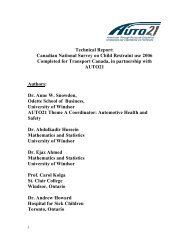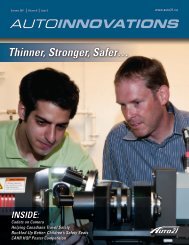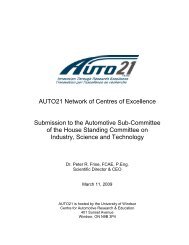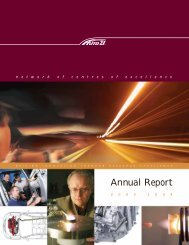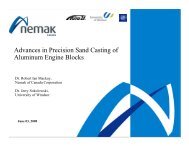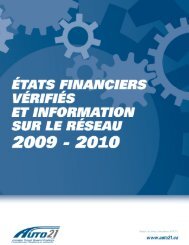Centre for Near-net-shape Processing of Materials - AUTO21
Centre for Near-net-shape Processing of Materials - AUTO21
Centre for Near-net-shape Processing of Materials - AUTO21
You also want an ePaper? Increase the reach of your titles
YUMPU automatically turns print PDFs into web optimized ePapers that Google loves.
<strong>Centre</strong> <strong>for</strong> <strong>Near</strong>-<strong>net</strong>-<strong>shape</strong> <strong>Processing</strong> <strong>of</strong> <strong>Materials</strong><strong>AUTO21</strong> Project C407-CMCAdvanced High Strength Metallic Components<strong>for</strong> Powertrain ApplicationsUniversities: Ryerson University, University <strong>of</strong> British Columbia,University <strong>of</strong> WaterlooIndustrial Partner: Nemak <strong>of</strong> Canada CorporationGovernment Partner: NRC- Canadian Neutron Beam <strong>Centre</strong> (CNBC)Speaker: Dr. C. (Ravi) Ravindran, Ryerson University
<strong>Centre</strong> <strong>for</strong> <strong>Near</strong>-<strong>net</strong>-<strong>shape</strong> <strong>Processing</strong> <strong>of</strong> <strong>Materials</strong>The Team<strong>Centre</strong> <strong>for</strong> <strong>Near</strong>-Net Shape <strong>Processing</strong> <strong>of</strong> <strong>Materials</strong>Anthony Lombardi, Francesco D’Elia,Ravi Ravindran, Alan MachinNemak <strong>of</strong> Canada CorporationRobert MacKayCanadian Neutron Beam <strong>Centre</strong> (CNBC)Dimitry Sediako
<strong>Centre</strong> <strong>for</strong> <strong>Near</strong>-<strong>net</strong>-<strong>shape</strong> <strong>Processing</strong> <strong>of</strong> <strong>Materials</strong>Special Acknowledgement<strong>AUTO21</strong> Network <strong>of</strong> <strong>Centre</strong>s<strong>of</strong> Excellence
<strong>Centre</strong> <strong>for</strong> <strong>Near</strong>-<strong>net</strong>-<strong>shape</strong> <strong>Processing</strong> <strong>of</strong> <strong>Materials</strong>Ryerson-Nemak-CNBC CollaborationNemak’s Concern:Potential permanent distortion <strong>of</strong> cylinderbores in V6 aluminum engine blockscontaining gray cast iron cylinder liners.
<strong>Centre</strong> <strong>for</strong> <strong>Near</strong>-<strong>net</strong>-<strong>shape</strong> <strong>Processing</strong> <strong>of</strong> <strong>Materials</strong>Distortion in V6 Engine BlocksGray Cast Iron LinerDistorted CylinderAl Cylinder BridgeModified 319 Al Alloy Engine BlockCylinder Bore Distortion: Perturbations in cylinder results in loss <strong>of</strong> seal incombustion chamber reducing engine operating efficiency.
<strong>Centre</strong> <strong>for</strong> <strong>Near</strong>-<strong>net</strong>-<strong>shape</strong> <strong>Processing</strong> <strong>of</strong> <strong>Materials</strong>Extent <strong>of</strong> DistortionPotential Effects1. Energy: Increased fuel and oil consumption2. Environment: Increased pollution (CO 2 , CO, HC)3. Economic: Potential recall situation = LostExample: Recall situations have been estimated to cost theglobal automotive industry approximately $9 billion annually*.Nemak was keen to be proactive!*Croot, M., “Avoiding Total Recall”, Manufacturing Today, June 29, 2007, accessed on January 27, 2012 fromhttp://www.manufacturingtoday-europe.com/article-page.php?contentid=2707&issueid=131
<strong>Centre</strong> <strong>for</strong> <strong>Near</strong>-<strong>net</strong>-<strong>shape</strong> <strong>Processing</strong> <strong>of</strong> <strong>Materials</strong>Research Objectives1. Prevention <strong>of</strong> Distortion1. Determine the cause <strong>of</strong> distortion2. Eliminate these causesPotential Result: Improved Engine Efficiency during Operation2. Optimization <strong>of</strong> Process ParametersPotential Impacts1. Reduction in production costs2. Improved integrity and consistency <strong>of</strong> product
<strong>Centre</strong> <strong>for</strong> <strong>Near</strong>-<strong>net</strong>-<strong>shape</strong> <strong>Processing</strong> <strong>of</strong> <strong>Materials</strong>Project Overview-Process-Analysis
<strong>Centre</strong> <strong>for</strong> <strong>Near</strong>-<strong>net</strong>-<strong>shape</strong> <strong>Processing</strong> <strong>of</strong> <strong>Materials</strong>Cosworth Casting ProcessCylinder blockcavity180˚ RotationCylinder blockcavity• Risers near the top <strong>of</strong> the cylinders and an integral chill inserted in bulkhead(near the bottom <strong>of</strong> the cylinders) result in large variation in cooling rate alongcylinders.
<strong>Centre</strong> <strong>for</strong> <strong>Near</strong>-<strong>net</strong>-<strong>shape</strong> <strong>Processing</strong> <strong>of</strong> <strong>Materials</strong>Post Casting ProcessesThermal Considerations• Thermal Sand Reclamation (TSR): 495 °C <strong>for</strong> 1 h• Solution Heat Treatment: 480 °C <strong>for</strong> 7.5 h• Quenching: Air cooling at rate <strong>of</strong> 70-100 °C/min• Ageing Treatment: 240 °C <strong>for</strong> 5 h• Dyno Testing: 180 °C <strong>for</strong> 20 hIn-service Operation: 180 °C; Time variable
<strong>Centre</strong> <strong>for</strong> <strong>Near</strong>-<strong>net</strong>-<strong>shape</strong> <strong>Processing</strong> <strong>of</strong> <strong>Materials</strong>Analysis• Macro Analysis: Measurement <strong>of</strong>Distortion (CMM)• Micro Analysis:– Optical Microscopy– SEM– TEM• Mechanical Testing:– Tensile Test (Ambient & 180 °C)– Rockwell Hardness– Vickers Hardness– Nanoindentation• Residual Stress– Neutron Diffraction• Al Cylinder Bridge• Gray Iron Cylinder LinersTensile GaugeZ = 0TopUpper MiddleLower MiddleBottomZ = -130 mmCross Section <strong>of</strong> Cylinder Bridge
<strong>Centre</strong> <strong>for</strong> <strong>Near</strong>-<strong>net</strong>-<strong>shape</strong> <strong>Processing</strong> <strong>of</strong> <strong>Materials</strong>Results to Date- Macro Analysis-Micro Analysis-Mechanical Testing-Residual Stress
<strong>Centre</strong> <strong>for</strong> <strong>Near</strong>-<strong>net</strong>-<strong>shape</strong> <strong>Processing</strong> <strong>of</strong> <strong>Materials</strong>Macro Analysis: Cylinder DistortionRadial Deviation from NominalDiameter (µm)302520151050-5-10-15-20Cylinder 6 Pr<strong>of</strong>ile0 40 80 120 160 200 240 280 320 360Angular Position (degrees)Z=-5mmZ= -25mmZ= -48.5mmRoundness (µm)Cylinder Depth (mm) Cylinder 2 Cylinder 4 Cylinder 6Z= -5 35 31 24Z= -25 20 20 15Z= -48.5 23 33 44
<strong>Centre</strong> <strong>for</strong> <strong>Near</strong>-<strong>net</strong>-<strong>shape</strong> <strong>Processing</strong> <strong>of</strong> <strong>Materials</strong>Micro Analysis: Optical MicroscopyCylinder (2-4) TSR TopCylinder (2-4) TSR Bottom200 µm200 µmSDAS (µm)50454035302520151050Average SDAS <strong>for</strong> Cylinder (2-4)BridgeTSR T7 DynoTreatment Condition(2-4) Bridge-Top(2-4) Bridge-Upper Middle(2-4) Bridge-Lower Middle(2-4) Bridge-Bottom• Variation in cooling rate causes coarse dendriticstructure at the top <strong>of</strong> the cylinder and refineddendrites at the bottom.
<strong>Centre</strong> <strong>for</strong> <strong>Near</strong>-<strong>net</strong>-<strong>shape</strong> <strong>Processing</strong> <strong>of</strong> <strong>Materials</strong>Al 17 Fe 3.2 Mn 0.8 Si 2Micro Analysis: SEM/BSEAl 2 CuAl-Mg-Si-CuAl-Mg-Si-CuSiSiAl 2 CuTop100 µmBottomAl 17 Fe 3.2 Mn 0.8 Si 20100 µmIntermetallics in Interdendritic RegionsAmount <strong>of</strong> Al 2 Cu (%)21.81.61.41.210.80.60.40.2Al 2 Cu Phase DistributionTSR T7 DynoTreatment ConditionCylinder (2-4)TopCylinder (4-6)TopCylinder (2-4)BottomCylinder (4-6)Bottom• Optimization <strong>of</strong> heat treatment parametersrequired to dissolve equilibrium Al 2 Cu moreeffectively.
<strong>Centre</strong> <strong>for</strong> <strong>Near</strong>-<strong>net</strong>-<strong>shape</strong> <strong>Processing</strong> <strong>of</strong> <strong>Materials</strong>Micro Analysis: TEMPrecipitates within α-Al DendritesTSRT7Al-Mg-Si-CuAl-CuAl-Mg-Si-CuDynoAl-CuAl-Mg-Si-Cu
<strong>Centre</strong> <strong>for</strong> <strong>Near</strong>-<strong>net</strong>-<strong>shape</strong> <strong>Processing</strong> <strong>of</strong> <strong>Materials</strong>Mechanical Testing: Tensile TestAluminum Alloy Cylinder BridgeAmbient Temp. TestElevated Temp. Test (175 °C)260260240240Strength (MPa)220200180160140YieldStrengthUltimateTensileStrengthStrength (MPa)220200180160140YieldStrengthUltimateTensileStrength120120100TSR T7 Dyno100TSR T7 DynoTreatment ConditionTreatment Condition• T7 heat treatment increased YS and UTS due to <strong>for</strong>mation <strong>of</strong> age hardening precipitates.Optimization <strong>of</strong> heat treatment parameters will further increase strength
<strong>Centre</strong> <strong>for</strong> <strong>Near</strong>-<strong>net</strong>-<strong>shape</strong> <strong>Processing</strong> <strong>of</strong> <strong>Materials</strong>Mechanical Testing: Rockwell HardnessRockwell Hardness <strong>for</strong>Cylinder (2-4) BridgeRockwell Hardness <strong>for</strong> Cylinder(4-6) Bridge9595Rockwell Hardness (HRE)90858075706560TSR T7 DynoCylinder(2-4) TopCylinder(2-4)BottomRockwell Hardness (HRE)90858075706560TSR T7 DynoCylinder(4-6) TopCylinder(4-6)BottomTreatment ConditionTreatment Condition• Refinement in microstructure resulted in higher hardness at the bottom <strong>of</strong> the cylinderindicating higher strength.
<strong>Centre</strong> <strong>for</strong> <strong>Near</strong>-<strong>net</strong>-<strong>shape</strong> <strong>Processing</strong> <strong>of</strong> <strong>Materials</strong>Mechanical Testing: NanoindentationHardness (GPa)121086420Al Matrix Al-Cu Si Al-Fe-Mn-SiCylinder (2-4) TSRTopCylinder (2-4) TSRBottomCylinder (2-4) T7TopCylinder (2-4) T7BottomCylinder (2-4)Dyno TopCylinder (2-4)Dyno BottomAl-Fe LinerInterface
<strong>Centre</strong> <strong>for</strong> <strong>Near</strong>-<strong>net</strong>-<strong>shape</strong> <strong>Processing</strong> <strong>of</strong> <strong>Materials</strong>Mechanical Testing: Nanoindentation1210Al-Fe-Mn-SiAl-CuHardness (GPa)8642Al-Fe-Mn-SiSiAl-Cu0-15 -10 -5 0 5 10 15ParticleDistance (µm)Matrix40 µm
<strong>Centre</strong> <strong>for</strong> <strong>Near</strong>-<strong>net</strong>-<strong>shape</strong> <strong>Processing</strong> <strong>of</strong> <strong>Materials</strong>Residual Stress: Neutron Diffraction250Al Cylinder Bridge <strong>of</strong> TSR EngineBlock250Al Cylinder Bridge <strong>of</strong> T7 EngineBlockStress (MPa)20015010050HoopStressRadialStressAxialStressStress (MPa)20015010050HoopStressRadialStressAxialStress00 10 20 30 40 50 60 70 80 90TopCylinder Location (mm)Bottom00 20 40 60 80 100 120Cylinder Location (mm)TopBottom• Residual Stress exceeds the 319 alloy yield strength in TSR making cylindersprone to distortion.•Top <strong>of</strong> cylinder most prone to distortion as suggested by significant stress relief.
<strong>Centre</strong> <strong>for</strong> <strong>Near</strong>-<strong>net</strong>-<strong>shape</strong> <strong>Processing</strong> <strong>of</strong> <strong>Materials</strong>Residual Stress: Neutron DiffractionStress (MPa)1501251007550250-25Gray Iron Liner <strong>of</strong> TSR Engine BlockTop0 20 40 60 80 100 120Cylinder Location (mm)HoopstressRadialstressAxialstressBottomStress (MPa)200-20-40-60-80-100-120Gray Iron Liner <strong>of</strong> Dyno Engine BlockTop0 20 40 60 80 100 120Cylinder Location (mm)BottomHoopStressRadialStressAxialStress• Machining and dyno testing <strong>of</strong> cylinder bores results in complete relief <strong>of</strong>tensile residual stress.•This relief may have resulted in permanent cylinder distortion.
<strong>Centre</strong> <strong>for</strong> <strong>Near</strong>-<strong>net</strong>-<strong>shape</strong> <strong>Processing</strong> <strong>of</strong> <strong>Materials</strong>ConclusionsComprehensive analysis along the cylinderbores revealed:1. Distortion is likely the result <strong>of</strong> large residual stresswith respect to alloy strength, specifically at the top<strong>of</strong> the cylinder.2. Component integrity can be improved through theoptimization <strong>of</strong> process parameters.
<strong>Centre</strong> <strong>for</strong> <strong>Near</strong>-<strong>net</strong>-<strong>shape</strong> <strong>Processing</strong> <strong>of</strong> <strong>Materials</strong>Project Achievements<strong>AUTO21</strong> HQP Poster Competition1. Lombardi, A., D’Elia, F., Ravindran, C., Sediako, D., Murty, B.S., and MacKay,R., “Cylinder Bore Distortion in V6 Al Engine Blocks”, ” <strong>AUTO21</strong> HighlyQualified Personnel (HQP) Poster Competition, Ottawa, Ontario, May 25-27, 2011. (Within top five across all themes)2. Lombardi, A., D’Elia, F., Ravindran, C., and MacKay, R., “DimensionalDistortions <strong>of</strong> A319 Al Engine Blocks with Cast-in Cylinder Liners” <strong>AUTO21</strong>Highly Qualified Personnel (HQP) Poster Competition, Windsor, Ontario,June 7-10, 2010. (1 st Prize in Theme. Within top five across all themes)<strong>AUTO21</strong> TestDRIVE CompetitionLombardi, A., “Optimization <strong>of</strong> Production Parameters to EliminateCylinder Distortion <strong>of</strong> Aluminum Engine Blocks”, Mississauga, Ontario,February 1, 2012. (2 nd Place)
<strong>Centre</strong> <strong>for</strong> <strong>Near</strong>-<strong>net</strong>-<strong>shape</strong> <strong>Processing</strong> <strong>of</strong> <strong>Materials</strong>Journal PublicationsProject Achievements1. Lombardi, A., D’Elia, F., Machin, A., Ravindran, C., MacKay, R., “Variation in Microstructure andMechanical Properties Along the Cylinder Bores <strong>of</strong> a Modified 319 Type Al Alloy Engine Block withCast-in Iron Liners” AFS Transactions, Vol. 119, pp. 229-238 (2011).2. Lombardi, A., D’Elia, F., Ravindran, C., Murty, B.S., MacKay, R., “Analysis <strong>of</strong> the Secondary Phases inthe Microstructure <strong>of</strong> 319 Type Al Alloy Engine Blocks using Electron Microscopy andNanoindentation”, Transactions <strong>of</strong> the Indian Institute <strong>of</strong> Metals, Vol. 64, pp. 7-11 (2011).3. Sediako, D., D’Elia, F., Lombardi, A., Machin, A., Ravindran, C., Hubbard, C., MacKay, R., “Analysis<strong>of</strong> Residual Stress Pr<strong>of</strong>iles in the Cylinder Web Region <strong>of</strong> an As-Cast V6 Al Engine Block withCast-In Fe Liners Using Neutron Diffraction”, SAE International Journal <strong>of</strong> <strong>Materials</strong> andManufacturing, Vol. 4, pp. 138-151 (2011).4. Lombardi, A., Sediako, D., D’Elia, F., Ravindran, C., MacKay, R., “Neutron Diffraction Study onResidual Stress in Aluminum Engine Blocks Following Machining and Service Testing”,SAE International Journal <strong>of</strong> <strong>Materials</strong> and Manufacturing, Vol. 5, pp. 115-121 (2012).5. Lombardi, A., D’Elia, F., Ravindran, C., Sediako, D., Murty, B.S., MacKay, R., “Interplay betweenResidual Stresses, Microstructure, Process Variables and Engine Block Casting Integrity”,Metallurgical and <strong>Materials</strong> Transactions A. (2012) (Accepted).
<strong>Centre</strong> <strong>for</strong> <strong>Near</strong>-<strong>net</strong>-<strong>shape</strong> <strong>Processing</strong> <strong>of</strong> <strong>Materials</strong>Where do we go?• Process Optimization• Continued Harmonious Collaborationbetween Ryerson-Nemak-NRC/CNBC
<strong>Centre</strong> <strong>for</strong> <strong>Near</strong>-<strong>net</strong>-<strong>shape</strong> <strong>Processing</strong> <strong>of</strong> <strong>Materials</strong>Acknowledgements• <strong>AUTO21</strong> Network <strong>of</strong> <strong>Centre</strong>s <strong>of</strong> Excellence• Natural Science and Engineering ResearchCouncil <strong>of</strong> Canada (NSERC)• B.S. Murty, I.I.T. Madras• CNPM: Sophie Lun Sin, Abdallah Elsayed



